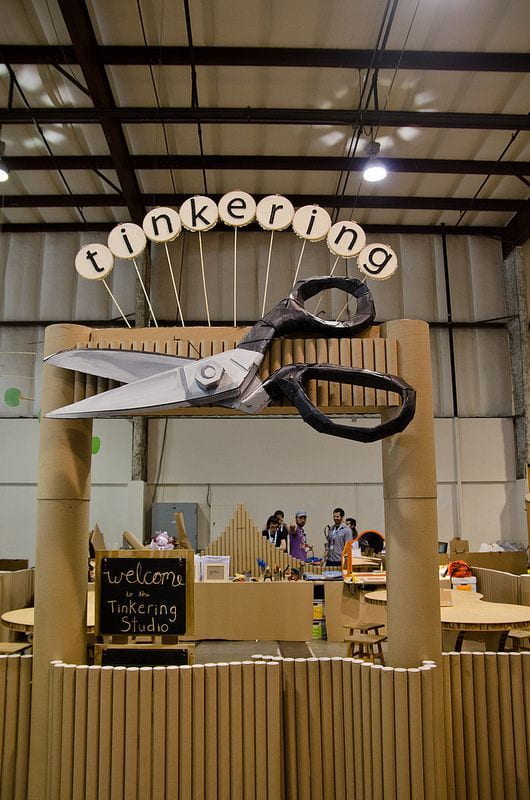Karen Wilkinson and Mike Petrich discuss “The Art of Tinkering” at Standford University. They share their ideas and ongoing activities at the Exploratorium in hopes that components of this interactive space would be integrated into museums, schools, homes, etc. The space is a blend of art, science, and technology to the degree that it makes it difficult for one to categorize each task or exercise. The center holds nannies, parents, young instructors, children, and other experienced or developing tinkerers. Children are able to investigate and problem-solve with guidance by loved ones or familiar faces young and old surrounded by works or creating temporary pieces that inspire and motivate others. Often other children that come into the space can re-imagine what is already there to make a contribution to the work as part of this cycle of an ongoing “project.” Tinkerers are able to make discoveries using a variety of materials and learn in an informal setting. Instructors encourage youngsters to keep on doing, making, exploring, backtracking, etc. in order to gain new knowledge and use what they just learned to make connections elsewhere. Students have the opportunity to create their own meaning and build memorable experiences as they decide which activities they would like to delve into and create their own goals through engagement. Makers may take intellectual risks and have the chance to use some complex, potentially harmful tools for the first time in an encouraging, safe environment. There is even design thinking for tinkerability in which experienced tinkerers have to think about the components of the activity, what the viewer’s surroundings will look, and how much guidance to give to those facing challenges (while still allowing the student to “fail” to learn). Instructors want to make sure that if a child “succeeds” and moves past a point in a task that it was not accidental, but rather intentional. Truly learning in tinkering involves being able to repeat the action again with little to no guidance. If it was accidental then that particular student may need more encouragement/guidance and time to reflect on their actions than others.
Aspects of the “Art of Tinkering” is shown in this course despite doing so remotely. Before we begin exploring the materials or tasks, we are shown some student examples of the assignment. Similar to endeavors within the Exploratorium, the examples highlight that there is no one particular way of going about the project. This leaves room for each one of us to be passionate about our own visions or ideas and have a goal in mind. Leaving behind the thought of having to follow an example is refreshing. Afterward, we are given the chance to interact with our peers during breakout groups in case a question arises or someone is in need while we work separately. This allows us to become teachers as we may guide another student to a solution. We share our “solutions” using our blogs as a platform knowing that there is always room for improvement. I could trace back a few steps, go in another direction, and have a different outcome than what I presented on my post. The fact that we are not posting one single “solution” or prototype reiterates the process of design thinking as part of the continuous cycle of learning. Being able to see my peers’ work and make comments lets me think about and take note of these other possible “solutions” moving forward into my own work. Having the ability to write about the challenges I have faced, what I found successful, and what could be worked on after these assignments are essential aspects of reflection.
After seeing images of children’s’ involvement at different stations within the Exploratorium I think I would really enjoy the “Light Play” activity. Using a slow-moving motor and various LEDs to explore geometry within the shifting light and shadows appears to be quite a visual experience. Making use of “materials,” such as (sun)light that is accessible to everyone is a great way for students to take their experience and prototype at home. I also believe that I would find the “Marble Machine/Run” engaging as it takes some trial and error when creating a board with supportive passways and/or obstacles placed at certain angles in order for the marble to go through. Once again, this activity can easily be carried outside of the Exploratorium. Common household products that children may already have can be used to experiment without feeling obligated to purchase or use pieces of wood/molding as pathways. Being inventive and making use of the materials one already has is an important aspect of tinkering as we each have access to different spaces. “Toy Dissection” seems like it would be a great way for me to gain new knowledge about different motors. I would appreciate the intricacy of wiring and being able to compact and conceal/disguise the wires with (many) layers within the mechanical toy. Breaking down an object or form (done so literally at the interactive space) is an interesting concept as we often as artists are so wrapped up in building and creating both psychical and conceptual layers ourselves.
